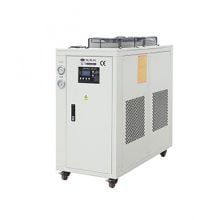We offer you 100% custom-made service Inquiry
An oil-cooled chiller operates by utilizing oil as the refrigerant rather than water.
The oil absorbs heat from the process, which is then removed by circulating it through a refrigeration system.
Subsequently, the chilled oil is employed to cool the process equipment. To attain the intended cooling effect, an oil-cooled chiller comprises multiple components that collaborate.
This article will delve into the distinct components of an oil-cooled chiller.

The central component of an oil-cooled chiller is the compressor, which works to compress the oil, raising both its pressure and temperature.
Oil-cooled chillers rely on two types of compressors, namely reciprocating and screw compressors.
Reciprocating compressors are highly efficient and require less maintenance, whereas screw compressors offer reliable and smooth operation.
The condenser serves as a device for transferring heat from the compressed oil, using a heat exchanger.
The heat is then transferred to either water or air, which then dissipates it to the surrounding environment.
The goal of the condenser is to achieve the highest possible level of heat transfer while keeping the pressure drop to a minimum through its design.
The purpose of the oil separator is to separate the oil from the refrigerant.
This is crucial to prevent the accumulation of oil in the evaporator, which can negatively impact the efficiency of heat transfer.
The oil separator is specifically designed to effectively remove oil from the refrigerant without interfering with the refrigeration cycle itself.
The evaporator is a component that functions as a heat exchanger, removing heat from process equipment.
This is accomplished by circulating cooled oil from the refrigeration system through the evaporator, which cools down the process equipment.
The design of the evaporator is intended to optimize heat transfer while simultaneously minimizing any pressure drop.
The expansion valve is a crucial component in controlling the flow of oil through the refrigeration system.
Its main purpose is to regulate the pressure and temperature of the oil to achieve the desired cooling effect.
In oil-cooled chillers, two types of expansion valves are typically used: thermostatic and electronic.
The thermostatic expansion valve is favored for its simple and reliable design, while the electronic expansion valve is valued for its accuracy and flexibility.
The heat exchanger is a critical component in the oil-cooled chiller system, as it facilitates the transfer of heat between the oil and the cooling medium.
Two types of heat exchangers are commonly used in oil-cooled chillers: shell and tube, and plate heat exchangers.
Shell and tube heat exchangers are recognized for their high efficiency and robust construction, while plate heat exchangers are appreciated for their compactness and ease of maintenance.
7.Refrigerant
The refrigerant is a substance that plays a critical role in the oil-cooled chiller system, as it absorbs and removes heat from the oil.
Several types of refrigerants are utilized in oil-cooled chillers, including R-134a, R-407C, and R-410A.
The control system plays an important role in monitoring and controlling the chiller's operation. It comprises sensors, controllers, and software that work together to ensure that the chiller functions efficiently and reliably.
By monitoring parameters such as temperature, pressure, and flow rate, the control system adjusts the operation of the compressor, pump, and other components to achieve the desired cooling effect.
Are you in need of an oil-cooled chiller for your industrial or commercial application?
Contact us today to discuss your cooling needs and let our team of experts help you find the perfect solution.
We pride ourselves on providing top-quality oil-cooled chillers that are efficient, reliable, and tailored to your specific requirements.
Don't wait any longer, get in touch with us now to learn more about our products and services
By continuing to use the site you agree to our privacy policy Terms and Conditions.